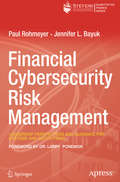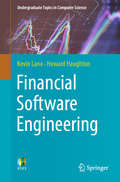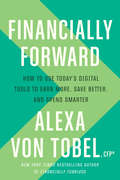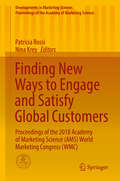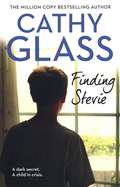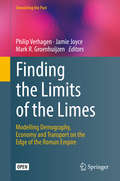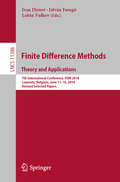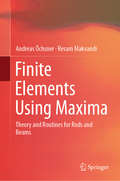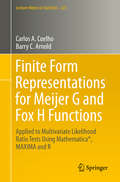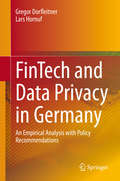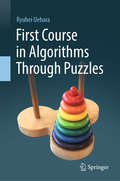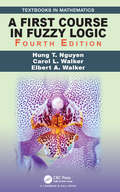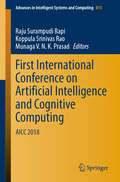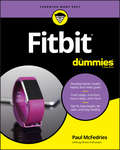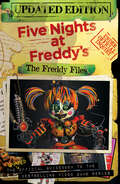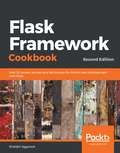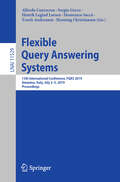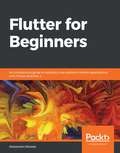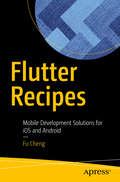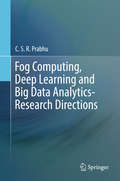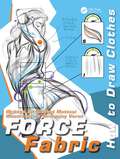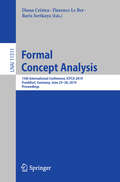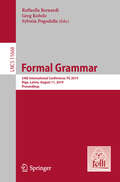- Table View
- List View
Financial Cybersecurity Risk Management: Leadership Perspectives and Guidance for Systems and Institutions
by Paul Rohmeyer Jennifer L. BayukUnderstand critical cybersecurity and risk perspectives, insights, and tools for the leaders of complex financial systems and markets. This book offers guidance for decision makers and helps establish a framework for communication between cyber leaders and front-line professionals. Information is provided to help in the analysis of cyber challenges and choosing between risk treatment options.Financial cybersecurity is a complex, systemic risk challenge that includes technological and operational elements. The interconnectedness of financial systems and markets creates dynamic, high-risk environments where organizational security is greatly impacted by the level of security effectiveness of partners, counterparties, and other external organizations. The result is a high-risk environment with a growing need for cooperation between enterprises that are otherwise direct competitors. There is a new normal of continuous attack pressures that produce unprecedented enterprise threats that must be met with an array of countermeasures. Financial Cybersecurity Risk Management explores a range of cybersecurity topics impacting financial enterprises. This includes the threat and vulnerability landscape confronting the financial sector, risk assessment practices and methodologies, and cybersecurity data analytics. Governance perspectives, including executive and board considerations, are analyzed as are the appropriate control measures and executive risk reporting.What You’ll LearnAnalyze the threat and vulnerability landscape confronting the financial sectorImplement effective technology risk assessment practices and methodologiesCraft strategies to treat observed risks in financial systemsImprove the effectiveness of enterprise cybersecurity capabilitiesEvaluate critical aspects of cybersecurity governance, including executive and board oversightIdentify significant cybersecurity operational challengesConsider the impact of the cybersecurity mission across the enterpriseLeverage cybersecurity regulatory and industry standards to help manage financial services risksUse cybersecurity scenarios to measure systemic risks in financial systems environmentsApply key experiences from actual cybersecurity events to develop more robust cybersecurity architecturesWho This Book Is For Decision makers, cyber leaders, and front-line professionals, including: chief risk officers, operational risk officers, chief information security officers, chief security officers, chief information officers, enterprise risk managers, cybersecurity operations directors, technology and cybersecurity risk analysts, cybersecurity architects and engineers, and compliance officers
Financial Software Engineering (Undergraduate Topics in Computer Science)
by Kevin Lano Howard HaughtonIn this textbook the authors introduce the important concepts of the financial software domain, and motivate the use of an agile software engineering approach for the development of financial software. They describe the role of software in defining financial models and in computing results from these models. Practical examples from bond pricing, yield curve estimation, share price analysis and valuation of derivative securities are given to illustrate the process of financial software engineering.Financial Software Engineering also includes a number of case studies based on typical financial engineering problems:*Internal rate of return calculation for bonds* Macaulay duration calculation for bonds* Bootstrapping of interest rates* Estimation of share price volatility* Technical analysis of share prices* Re-engineering Matlab to C#* Yield curve estimation* Derivative security pricing* Risk analysis of CDOs The book is suitable for undergraduate and postgraduate study, and for practitioners who wish to extend their knowledge of software engineering techniques for financial applications
Financially Forward: How to Use Today's Digital Tools to Earn More, Save Better, and Spend Smarter
by Alexa von TobelChief digital officer at Northwestern Mutual, founder/CEO of LearnVest, and New York Times bestelling author shows how to use the simple tools of the digital age to get more out of our money.We live in a new financial world. Our wallets--like every other aspect of our lives--have gone fully digital. From mobile pay to on-demand everything to cryptocurrencies, technology is rewriting the rules for how we earn, save, spend and invest. Technology has made virtually every aspect of our lives cheaper and more convenient. Shouldn't it do the same when it comes to managing our finances?Von Tobel says that it can. In this straightforward and jargon-free guide, she shows us how to use the simple tools found on any smartphone to put more money back into our wallets. Readers will learn: Six new trends that are impacting our finances - and how to optimize them How to navigate the world of mobile pay, and cash in by going cash-free How to save time and money by putting your savings--and spending--on autopilot Best practices for keeping your identity and financial accounts ultra-secure How to talk to digital natives - ie your kids - about financial planning What the Bitcoin hype is all about and how to prepare for the future of digital moneyPreparing ourselves for the financial future gives us the security and freedom to live our richest lives. It's time to move Financially Forward...or get left behind.
Find The Girl: All That Glitters
by Lucy ConnellNancy Palmer used to be Insta-famous and her twin Nina used to shy away from everyone. Things can change pretty quickly. Nina has been accepted onto a Guildhall music course and is famous because of her pop star boyfriend, Chase. Nancy is trying to put her name on the map by becoming a music journalist and is not getting distracted by Chase's hot bandmate Miles. When their estranged dad shows up out of the blue and shows an interest in Nina's budding music career, Nancy isn't sure he's just there to make amends. As they attempt to find their way through new challenges, they both have to remember that you have to pave your own path to success and sometimes fame comes at a price.
Finding New Ways to Engage and Satisfy Global Customers: Proceedings of the 2018 Academy of Marketing Science (AMS) World Marketing Congress (WMC) (Developments in Marketing Science: Proceedings of the Academy of Marketing Science)
by Patricia Rossi Nina KreyThis proceedings volume explores the new and innovative ways in which marketers find new global customers and build meaningful bridges to them based on their wants and needs in order to ensure high levels of customer satisfaction. Customer loyalty is ensured through continuous engagement with an ever-changing and demanding customer base. Global forces are bringing cultures into collision, creating new challenges for firms wanting to reach geographically and culturally distant markets, and causing marketing managers to rethink how to build meaningful and stable relationships with evermore demanding customers. In an era of vast new data sources and a need for innovative analytics, the challenge for the marketer is to reach customers in new and powerful ways. Featuring the full proceedings from the 2018 Academy of Marketing Science (AMS) World Marketing Congress (WMC) held in Porto, Portugal, this volume provides current and emerging research from global scholars and practitioners that will help marketers to engage and promote customer satisfaction. Founded in 1971, the Academy of Marketing Science is an international organization dedicated to promoting timely explorations of phenomena related to the science of marketing in theory, research, and practice. Among its services to members and the community at large, the Academy offers conferences, congresses, and symposia that attract delegates from around the world. Presentations from these events are published in this Proceedings series, which offers a comprehensive archive of volumes reflecting the evolution of the field. Volumes deliver cutting-edge research and insights, complementing the Academy’s flagship journals, the Journal of the Academy of Marketing Science (JAMS) and AMS Review. Volumes are edited by leading scholars and practitioners across a wide range of subject areas in marketing science.
Finding Stevie
by Cathy GlassFinding Stevie is a dark and poignant true story that highlights the dangers lurking on online. <p><p> When Stevie's social worker tells Cathy, an experienced foster carer, that Stevie, 14, is gender fluid she isn't sure what that term means and looks it up. <p> Stevie, together with his younger brother and sister, have been brought up by their grandparents as their mother is in prison. But the grandparents can no longer cope with Stevie's behaviour so they place him in care. <p> Stevie is exploring his gender identity, and like many young people he spends time online. Cathy warns him about the dangers of talking to strangers online and advises him how to stay safe. When his younger siblings tell their grandmother that they have a secret they can't tell, Cathy is worried. However, nothing could have prepared her for the truth when Stevie finally breaks down and confesses what he's done.
Finding the Limits of the Limes: Modelling Demography, Economy and Transport on the Edge of the Roman Empire (Computational Social Sciences)
by Philip Verhagen Jamie Joyce Mark R. GroenhuijzenThis open access book demonstrates the application of simulation modelling and network analysis techniques in the field of Roman studies. It summarizes and discusses the results of a 5-year research project carried out by the editors that aimed to apply spatial dynamical modelling to reconstruct and understand the socio-economic development of the Dutch part of the Roman frontier (limes) zone, in particular the agrarian economy and the related development of settlement patterns and transport networks in the area. The project papers are accompanied by invited chapters presenting case studies and reflections from other parts of the Roman Empire focusing on the themes of subsistence economy, demography, transport and mobility, and socio-economic networks in the Roman period.The book shows the added value of state-of-the-art computer modelling techniques and bridges computational and conventional approaches. Topics that will be of particular interest to archaeologists are the question of (forced) surplus production, the demographic and economic effects of the Roman occupation on the local population, and the structuring of transport networks and settlement patterns. For modellers, issues of sensitivity analysis and validation of modelling results are specifically addressed. This book will appeal to students and researchers working in the computational humanities and social sciences, in particular, archaeology and ancient history.
Finite Difference Methods. Theory and Applications: 7th International Conference, FDM 2018, Lozenetz, Bulgaria, June 11-16, 2018, Revised Selected Papers (Lecture Notes in Computer Science #11386)
by Lubin Vulkov István Faragó Ivan DimovThis book constitutes the refereed conference proceedings of the 7th International Conference on Finite Difference Methods, FDM 2018, held in Lozenetz, Bulgaria, in June 2018.The 69 revised full papers presented together with 11 invited papers were carefully reviewed and selected from 94 submissions. They deal with many modern and new numerical techniques like splitting techniques, Green’s function method, multigrid methods, and immersed interface method.
Finite Elements Using Maxima: Theory and Routines for Rods and Beams
by Andreas Öchsner Resam MakvandiThis book provides a study aid on the finite element method. Based on the free computer algebra system “Maxima”, it presents routines to symbolically or numerically solve problems in the context of plane truss and frame structures. This allows readers to not only check classical “hand calculations” but also understand the computer implementation of the method. The mechanical theories focus on the classical one-dimensional structural elements, i.e. bars, Euler–Bernoulli and Timoshenko beams as well as their combination to generalized beam elements. Focusing on one-dimensional elements reduces the complexity of the mathematical framework and the resulting matrix equations can still be displayed with all components, and not only in a symbolic representation. The use of a computer algebra system and the incorporated functions, e.g. for equation solving, highlights the methodology of the finite element method rather than standard procedures.The book is based on the Springer Brief “Finite Elements for Truss and Frame Structures” (978-3-319-94940-6) by the same authors.
Finite Form Representations for Meijer G and Fox H Functions: Applied to Multivariate Likelihood Ratio Tests Using Mathematica®, MAXIMA and R (Lecture Notes in Statistics #223)
by Carlos A. Coelho Barry C. ArnoldThis book depicts a wide range of situations in which there exist finite form representations for the Meijer G and the Fox H functions. Accordingly, it will be of interest to researchers and graduate students who, when implementing likelihood ratio tests in multivariate analysis, would like to know if there exists an explicit manageable finite form for the distribution of the test statistics. In these cases, both the exact quantiles and the exact p-values of the likelihood ratio tests can be computed quickly and efficiently.The test statistics in question range from common ones, such as those used to test e.g. the equality of means or the independence of blocks of variables in real or complex normally distributed random vectors; to far more elaborate tests on the structure of covariance matrices and equality of mean vectors. The book also provides computational modules in Mathematica®, MAXIMA and R, which allow readers to easily implement, plot and compute the distributions of any of these statistics, or any other statistics that fit into the general paradigm described here.
FinTech and Data Privacy in Germany: An Empirical Analysis with Policy Recommendations
by Gregor Dorfleitner Lars HornufThis book examines the FinTech revolution from a data privacy perspective. It analyzes key players on the FinTech market and the developments in various market segments. Particular attention is paid to an empirical analysis of the privacy statements of 505 German FinTech firms and how they were adapted after the General Data Protection Regulation (GDPR) entered into effect in May 2018. The analysis also includes 38 expert interviews with relevant stakeholders from supervisory and regulatory authorities, the financial and FinTech industry, leading consulting firms and consumer protection agencies. By adopting this approach, the book identifies key regulatory needs, offers a valuable asset for practitioners and academics alike, and shares intriguing insights for lawyers, economists and everyone interested in FinTech and data privacy.
First Course in Algorithms Through Puzzles
by Ryuhei UeharaThis textbook introduces basic algorithms and explains their analytical methods. All algorithms and methods introduced in this book are well known and frequently used in real programs. Intended to be self-contained, the contents start with the basic models, and no prerequisite knowledge is required. This book is appropriate for undergraduate students in computer science, mathematics, and engineering as a textbook, and is also appropriate for self-study by beginners who are interested in the fascinating field of algorithms. More than 40 exercises are distributed throughout the text, and their difficulty levels are indicated. Solutions and comments for all the exercises are provided in the last chapter. These detailed solutions will enable readers to follow the author’s steps to solve problems and to gain a better understanding of the contents. Although details of the proofs and the analyses of algorithms are also provided, the mathematical descriptions in this book are not beyond the range of high school mathematics. Some famous real puzzles are also used to describe the algorithms. These puzzles are quite suitable for explaining the basic techniques of algorithms, which show how to solve these puzzles.
A First Course in Fuzzy Logic (Textbooks in Mathematics)
by Hung T. Nguyen Carol L. Walker Elbert A. Walker<p>A First Course in Fuzzy Logic, Fourth Edition is an expanded version of the successful third edition. It provides a comprehensive introduction to the theory and applications of fuzzy logic. <p>This popular text offers a firm mathematical basis for the calculus of fuzzy concepts necessary for designing intelligent systems and a solid background for readers to pursue further studies and real-world applications. <p>New in the Fourth Edition: <p> <li>Features new results on fuzzy sets of type-2 <li>Provides more information on copulas for modeling dependence structures <li>Includes quantum probability for uncertainty modeling in social sciences, especially in economics</li> <p>With its comprehensive updates, this new edition presents all the background necessary for students, instructors and professionals to begin using fuzzy logic in its many—applications in computer science, mathematics, statistics, and engineering. </p>
First International Conference on Artificial Intelligence and Cognitive Computing: Aicc 2018 (Advances In Intelligent Systems and Computing #815)
by Raju Surampudi Bapi Koppula Srinivas Rao Munaga V. PrasadThis book presents original research works by researchers, engineers and practitioners in the field of artificial intelligence and cognitive computing. The book is divided into two parts, the first of which focuses on artificial intelligence (AI), knowledge representation, planning, learning, scheduling, perception-reactive AI systems, evolutionary computing and other topics related to intelligent systems and computational intelligence. In turn, the second part focuses on cognitive computing, cognitive science and cognitive informatics. It also discusses applications of cognitive computing in medical informatics, structural health monitoring, computational intelligence, intelligent control systems, bio-informatics, smart manufacturing, smart grids, image/video processing, video analytics, medical image and signal processing, and knowledge engineering, as well as related applications.
Fitbit For Dummies
by Paul McFedriesTake a complete tour of the Fitbit ecosystem From Fitbit features to the Fitbit app to the social features of Fitbit.com, this approachable book covers everything you need to know to get the most out of your Fitbit wristband or watch. Whether you’re a fitness newcomer, a regular walker, or a long-time exerciser, your Fitbit is a powerful device that can tell you much more than how many steps you take each day. This book offers easy-to-follow, step-by-step instructions for tracking all that data and getting the most out of your Fitbit investment. Go beyond steps to track sleep, heart rate, weight, and more Set up your health and fitness goals — then go for them! Connect to third-party apps such as Strava and Weight Watchers Stay motivated by sharing your activities with friends It’s one thing to simply wear your Fitbit, but it’s quite another to use your Fitbit to reach your personal health goals. Whether that goal is to get fit, lose weight, eat better, or reduce stress, your Fitbit has settings and features that can help you get there. And this book shows you how!
Five Nights At Freddy's: The Freddy Files (Five Nights At Freddy's Ser.)
by Scott CawthonThe bestselling Freddy Files is back, now updated with 64 pages of new content!The bestselling, official guidebook to Five Nights at Freddy's is back, now updated and including 64 pages of new content exploring Freddy Fazbear's Pizzeria Simulator and Ultimate Custom Night!In this official guidebook to Five Night at Freddy's, fans and gamers alike can immerse themselves in the series' mythology, gameplay, and secrets as we unwind the twisted mysteries hidden at the heart of Freddy Fazbear's Pizza. Delving into each game, players can map the animatronics' paths, learn how timed elements of the games work, and discover how to trigger unique events. Special sections throughout highlight Freddy's fans' most talked-about theories, from the identities of the "Bite of '83 and '87" victims to the history of Henry and William Afton to the recurring hallucinations of "it's me." All the evidence, along with every detail of the games, books, and more, is laid out for fans to explore in this one-of-a-kind guide to the warped world of Five Nights at Freddy's.
Flask Framework Cookbook: Over 80 proven recipes and techniques for Python web development with Flask, 2nd Edition
by Shalabh AggarwalBuild state-of-the-art web applications quickly and efficiently using Flask and related technologies with Python 3 Key Features Updated to Flask 1.0.3 and Python 3.7 with coverage of Microservices Get the most out of the powerful Flask framework and maintain the flexibility of your design choices Write cleaner and maintainable code with the help of sample apps Book Description Flask, the lightweight Python web framework, is popular due to its powerful modular design that lets you build scalable web apps. With this recipe-based guide, you'll explore modern solutions and best practices for Flask web development. Updated to the latest version of Flask and Python 3, this second edition of Flask Framework Cookbook moves away from some of the old and obsolete libraries and introduces recipes on bleeding edge technologies. You'll discover different ways of using Flask to create, deploy, and manage microservices. This Flask Python book starts by covering the different configurations that a Flask application can make use of, and then helps you work with templates and learn about the ORM and view layers. You'll also be able to write an admin interface and get to grips with debugging and logging errors. Finally, you'll grasp a variety of deployment and post-deployment techniques for platforms such as Apache, Tornado, and Heroku. By the end of this book, you'll have gained all the knowledge you need to write Flask applications in the best possible way and scale them using standard industry practices. What you will learn Explore web application development in Flask, right from installation to post-deployment stages Make use of advanced templating and data modeling techniques Discover effective debugging, logging, and error handling techniques in Flask Integrate Flask with different technologies such as Redis, Sentry, and MongoDB Deploy and package Flask applications with Docker and Kubernetes Design scalable microservice architecture using AWS LambdaContinuous integration and Continuous deployment Who this book is for If you are a web developer who wants to learn more about developing scalable and production-ready applications in Flask, this is the book for you. You'll also find this book useful if you are already aware of Flask's major extensions and want to use them for better application development. Basic Python programming experience along with basic understanding of Flask is assumed.
Flexible Query Answering Systems: 13th International Conference, FQAS 2019, Amantea, Italy, July 2–5, 2019, Proceedings (Lecture Notes in Computer Science #11529)
by Alfredo Cuzzocrea Sergio Greco Henrik Legind Larsen Domenico Saccà Troels Andreasen Henning ChristiansenThis book constitutes the refereed proceedings of the 13th International Conference on Flexible Query Answering Systems, FQAS 2019, held in Amantea, Italy, in July 2019.The 27 full papers and 10 short papers presented were carefully reviewed and selected from 43 submissions. The papers present emerging research trends with a special focus on flexible querying and analytics for smart cities and smart societies in the age of big data. They are organized in the following topical sections: flexible database management and querying; ontologies and knowledge bases; social networks and social media; argumentation-based query answering; data mining and knowledge discovery; advanced flexible query answering methodologies and techniques; flexible query answering methods and techniques; flexible intelligent information-oriented and network-oriented approaches; big data veracity and soft computing; flexibility in tools; and systems and miscellanea.
Flutter for Beginners: An introductory guide to building cross-platform mobile applications with Flutter and Dart 2
by Alessandro BiessekA step-by-step guide to learning Flutter and Dart 2 for creating Android and iOS mobile applications Key Features Get up to speed with the basics of Dart programming and delve into Flutter development Understand native SDK and third-party libraries for building Android and iOS applications using Flutter Package and deploy your Flutter apps to achieve native-like performance Book Description Google Flutter is a cross-platform mobile platform that makes it easier to write secure and high-performance native apps for iOS and Android. This book begins by introducing you to the Flutter framework and basics of Dart. You'll learn to set up the development environment to get started with your Flutter project. The book will guide you through designing the user interface and user input functions for your app. As you progress, you'll explore the navigator widget to manage your app routes and understand how to add transitions between screens. You'll then get to grips with developing your own plugin and discover how to structure good plugin code. The book will help you display a map from the Flutter app, add markers and interactions to it, and use the Google Places API. You'll build on your knowledge by not only adding tests to create a bug-free app, but also preparing it for deployment on Apple's App Store and Google Play. In later chapters, you'll learn to improve the user experience with advanced features such as map integrations, platform-specific code with native programming languages, and personalized animation options for designing intuitive UIs. By the end of this book, you'll be well-versed with Dart programming and have the skills to develop your own mobile apps or build a career as a Dart and Flutter app developer. What you will learn Understand the fundamentals of the Dart programming language Explore the core concepts of the Flutter UI and how it compiles for multiple platforms Develop Flutter plugins and widgets and understand how to structure good plugin code Style your apps with widgets and learn the difference between stateful and stateless widgets Add animation to your UI using Flutter's AnimatedBuilder component Integrate your native code into your Flutter codebase for native app performance Who this book is for This book is for developers looking to learn Google's revolutionary framework, Flutter from scratch. No knowledge of Flutter or Dart is required. However, basic programming language knowledge will be helpful.
Flutter Recipes: Mobile Development Solutions for iOS and Android
by Fu ChengTake advantage of this comprehensive reference to solving common problems when developing with Flutter. Along with an introduction to the basic concepts of Flutter development, the recipes in this book cover all important aspects of this emerging technology, including development, testing, debugging, performance tuning, app publishing, and continuous integration. Although Flutter presents a rich, cross-platform mobile development framework, helpful documentation is not easily found. Here you’ll review solutions to various scenarios and use creative, tested ways to accomplish everything from simple to complex development tasks. Flutter is developed using Dart and contains a unique technology stack that sets it apart from its competitors. This book takes the mystery out of working with the Dart language and integrating Flutter into your already existing workflows and development projects. With Flutter Recipes, you’ll learn how to build and deploy apps freshly started in Flutter, as well as apps already in progress, while side-stepping any potential roadblocks you may face along the way. What You'll LearnDebug with Dart ObservatoryProgram accessibility and localization featuresBuild and release apps for iOS and AndroidIncorporate reactive programmingWho This Book Is ForMobile developers with some experience in other frameworks who would like to work with the growing and popular Flutter.
Fog Computing, Deep Learning and Big Data Analytics-Research Directions
by C.S.R. PrabhuThis book provides a comprehensive picture of fog computing technology, including of fog architectures, latency aware application management issues with real time requirements, security and privacy issues and fog analytics, in wide ranging application scenarios such as M2M device communication, smart homes, smart vehicles, augmented reality and transportation management. This book explores the research issues involved in the application of traditional shallow machine learning and deep learning techniques to big data analytics. It surveys global research advances in extending the conventional unsupervised or clustering algorithms, extending supervised and semi-supervised algorithms and association rule mining algorithms to big data Scenarios. Further it discusses the deep learning applications of big data analytics to fields of computer vision and speech processing, and describes applications such as semantic indexing and data tagging. Lastly it identifies 25 unsolved research problems and research directions in fog computing, as well as in the context of applying deep learning techniques to big data analytics, such as dimensionality reduction in high-dimensional data and improved formulation of data abstractions along with possible directions for their solutions.
The FORCE Companion: Quick Tips and Tricks (Force Drawing Series)
by Mike Mattesi Swendly BeniliaSwendly Benilia shares with us simple and tangible tips and tricks to understanding and drawing FORCE across hundreds of drawings full of dunamism and energy! This book is an expellant companion to the FORCE brand since it delivers hundreds of FORCE drawings with succinct notations, filtered and approved by Mike Mattesi, about how to improve your FORCE drawing skills Key Features: Hundreds of dynamic FORCE drawing that inspire the reader to see and draw FORCE Succinct tips and tricks keep it light and educational The tips and tricks not only explain how but also why the drawings are successful. This is unique to the FORCE Drawing method Each page shares numerous drawing around a FORCE idea with a short paragraph to further clarify the FORCE tip or trick. Explaining to the reader why the drawings work increases their ability of achieving the same level of excellence Swendly Benilia is a professional character designer and illustrator. During his five years in the field he contributed with artwork for various game and publishing projects. Swendly also instructs FORCE Drawing. Michael Mattesi has authored four FORCE books, published in numerous languages, utilized around the world to inspire and educate artists on the concept of FORCE. He has instructed FORCE Drawing for over twenty years and inspired thousands of artists. Simultaneously, Michael has been contributing his skills as a professional artists on numerous award-winning projects in varied capacities and has collaborated with Pixar, Walt Disney Feature Animation, Walt Disney Consumer Products, Marvel Comics, Hasbro Toys, ABC, Microsoft, Electronic Arts, DreamWorks/PDI, Zynga, The School of Visual Arts, Beijing University, Art Center, Scuola Internazionale di Comics, San Jose State University. The Academy of Art University, Nickelodeoan, LeapFrog and many others. Micael’s students occupy all fields of the art industry and have themselves gained prestige for their abilities. Michael lives in northern California with his wife and two daughters. Visit him at: DrawingFORCE.com and connect with Michael on Facebook at: DrawingFORCE.com with Mike Mattesi or email him directly: mike@drawingforce.com Key Features Hundreds of dynamic FORCE drawings that inspire the reader to see and draw FORCE. Compact tips and tricks keep it light and educational. The tips and tricks explain how and why the drawings are successful. Explaining to the you why the drawings work increases your ability of achieving the same level of excellence.
FORCE Fabric: How to Draw Clothes (Force Drawing Series)
by Mike MattesiThe nude figure defines the best way to learn the fundamentals of drawing, yet the end goal of most art presents clothed figures, be it animation, video games, film, or fine art. This sixth book in the ‘FORCE’ series instructs artists on how to understand fabric with FORCE, thus leading to improved drawings of clothed figures. Expertly organized and beautifully illustrated, the book instructs artists to see clothing in a new way, through FORCE. Michael’s clear, concise, and informal writing coupled with Mritunjay and Michael’s FORCE drawings of clothed models comprehensibly informs you, the curious artist, to identify and draw FORCE clothing. Key Features: The unique, dynamic FORCE Drawing learning system that has helped thousands of artists enhance their figure drawing abilities now brings clothing to the figure! Easy to follow fundamentals on drawing clothed figures for games, animation, film, or fine art A clear, organized, and understandable, step-by-step approach to learn about the effects of FORCE on fabric and how that pertains to drawing clothes Learn to see clothes through tight, medium, and loose-fit and discover the common fold types per category, making it easier to identify and draw A ‘sticker system’ that presents the different types of folds found in different fit types of clothing Each chapter has exercises you can use to help you learn the process of drawing clothes Find out how line can bring the texture of different fabrics to your clothing drawings Includes robust author website with further information, forums, and videos Color-coded page edges to quickly find the material you need Unlock your imagination; put the theory into practice with detailed exercises to sharpen your skills
Formal Concept Analysis: 15th International Conference, ICFCA 2019, Frankfurt, Germany, June 25–28, 2019, Proceedings (Lecture Notes in Computer Science #11511)
by Diana Cristea Florence Le Ber Baris SertkayaThis book constitutes the proceedings of the 15th International Conference on Formal Concept Analysis, ICFCA 2019, held in Frankfurt am Main, Germany, in June 2019.The 15 full papers and 5 short papers presented in this volume were carefully reviewed and selected from 36 submissions. The book also contains four invited contributions in full paper length. The field of Formal Concept Analysis (FCA) originated in the 1980s in Darmstadt as a subfield of mathematical order theory, with prior developments in other research groups. Its original motivation was to consider complete lattices as lattices of concepts, drawing motivation from philosophy and mathematics alike. FCA has since then developed into a wide research area with applications much beyond its original motivation, for example in logic, data mining, learning, and psychology.
Formal Grammar: 24th International Conference, FG 2019, Riga, Latvia, August 11, 2019, Proceedings (Lecture Notes in Computer Science #11668)
by Raffaella Bernardi Greg Kobele Sylvain PogodallaEdited in collaboration with FoLLI, the Association of Logic, Language and Information, this book constitutes the refereed proceedings of the 24th International Conference on Formal Grammar, FG 2019, held in Riga, Latvia, in August 2019, in conjunction with the 31st European Summer School in Logic, Language and Information, ESSLI 2019.The 7 full papers presented were carefully reviewed and selected from 11 submissions. They present new and original research on formal grammar, mathematical linguistics, and the application of formal and mathematical methods to the study of natural language and focus on topics such as formal and computational phonology, morphology, syntax, semantics, and pragmatics; model-theoretic and proof-theoretic methods in linguistics; logical aspects of linguistic structure; constraint-based and resource-sensitive approaches to grammar; learnability of formal grammar; integration of stochastic and symbolic models of grammar; foundational, methodological, and architectural issues in grammar and linguistics; and mathematical foundations of statistical approaches to linguistic analysis.
